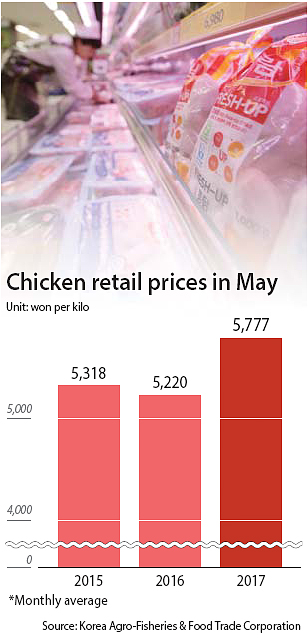Chicken prices rise as demand exceeds supply

The average retail price for 1 kilogram of fresh chicken was 5,827 won on Tuesday, according to the Korea Agro-Fisheries & Food Trade Corporation. This is almost 10 percent more than last year’s 5,309 won. Consumer prices for chicken have been generally on the rise this year: May’s average price so far is 5,777 won. January’s monthly average was 5,062 won and chicken was 5,577 won in April.
On May 18, the top three discount chains simultaneously had a price hike. E-Mart and Lotte Mart both raised prices by 1,000 won to 6,980 won and 6,900 won per one kilo of fresh chicken, respectively. Homeplus increased prices from 5,790 to 5,990 won.
“The price hike was induced by increased demand and rising producer prices. Consumer demand for chicken generally goes up when the weather starts getting warm for the summer,” said one industry source. Fresh chicken is the main ingredient for Samgyetang, or Korean chicken ginseng soup, a must-have for Koreans during the summer as a way to restore energy from sweating.
The Korea Rural Economic Institute said in a report released in late April that the long holiday season that fell in the first and second weeks of May would boost chicken prices as picnics and meals at home would generally increase during the season.
The hike is also evident in producer prices. According to the Korea Institute for Animal Products Quality Association, farm prices of chicken were 2,534 won per kilo, which is double the amount of the same day last year and a 21.2 percent increase from the previous month.
The fluctuation of chicken’s consumer prices this year is rooted in the unstable supply prompted from a nasty bird flu that swept South Jeolla in winter. Many hens and chicks were killed, affecting the supply of chicken that should have been on supermarket shelves by now.
The exports supply that accounts for a quarter of the chicken consumed in Korea doesn’t seem to compensating for the shortage either. American chicken, chicks and eggs were banned from imports to Korea in March after the outbreak of an avian influenza. Brazilian chicken, which made up 83 percent of the imported amount, became a problem after some of the country’s exporters were caught selling rotten chicken.
KREI expected that the number of chicken slaughtered for food in May will decrease 10.1 percent compared to the previous year and that the price hikes for chicken are likely to continue through July. The May report also added that the number of chicks born will increase to a stable level starting in September.
Egg prices rose to 8,000 won on Tuesday. In January, the average price of 30 eggs reached 9,000 won but the prices soon fell to between 7,300 and 7,900 won between February and April, thanks to government efforts to import fresh eggs from abroad.
BY SONG KYOUNG-SON [song.kyoungson@joongang.co.kr]










with the Korea JoongAng Daily
To write comments, please log in to one of the accounts.
Standards Board Policy (0/250자)